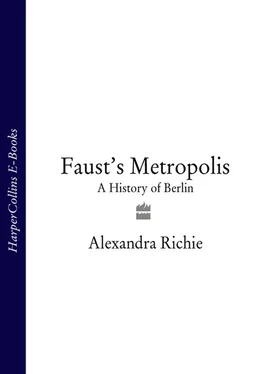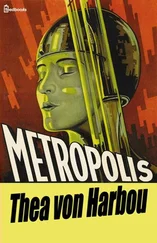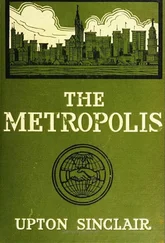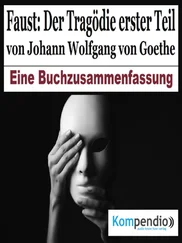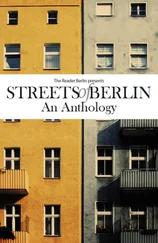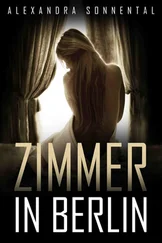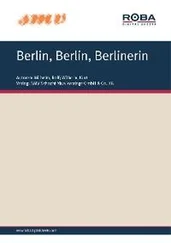In purely physical terms it is impossible to escape the evidence of Nazism in Berlin, the more so now that the Wall has been removed, exposing and drawing attention to artefacts long hidden or forgotten. Reminders of this history are everywhere: in the tunnels which planners must take account of when developing new buildings; in the segments of Goebbels’s Propaganda Ministry which, contrary to popular belief, was not completely destroyed and is still in use; in the huge column of concrete hidden behind a few scrubby bushes, all that is left of Speer’s attempt to test the foundations of the huge dome for Germania; in the East – West Axis, now the Strasse des 17 Juni, still lit by Speer’s prominent streetlamps. The reconstruction of Berlin is throwing up long-lost reminders of the conflict: on 15 September 1994 one of 15,000 war-time bombs exploded at a construction site killing three people and blowing a huge hole in the side of a building; the remains of Goebbels’ bunker and Hitler’s Chancellery bunker have been exposed, and construction workers frequently come across the skeletons of those who died in the Battle for Berlin. 76This is one German city in which the Aufarbeitung der Geschichte , the working through of history, cannot be put aside. Questions about how to ‘come to terms with’ the Nazi past permeate virtually every aspect of the city’s new role, including its suitability as the new German capital.
The history of Nazi criminality has been a source of controversy in Germany since 1945. Attempts to address the involvement of ordinary Germans in the form of the Allied Fragebogen – the de-Nazification procedure – or in the Nuremberg Trials were quickly forgotten after the war as most Germans tried to drew a veil over their past in the Stunde Null or Zero Hour of 1945. The advent of the Cold War was a boon to all those keen to hide their involvement in the old regime; moreover, both the western Allies and the Soviets made extensive use of NSDAP members in the rebuilding of their respective Germanys. Historiography was written to reflect the new Cold War world. Russia’s captive East Germans were taught a highly fictitious version of history which included the bizarre notion that all Hitlerfascisten had moved to the west in 1945 and that all those who remained were innocent of any involvement in the Third Reich. West Germans did produce some interesting work, particularly Friedrich Meinecke’s Die deutsche Katastrophe , which hinted at the historical roots of Nazism, but most popular histories encouraged the view that the entire period had been an aberration during which the nation had been led to ruin by the demonic Hitler – a view which conveniently allowed most people to forget their own support of the regime. Most West Germans looked to the future and poured their energy into the Wirtschaftswunder – the economic miracle. The East Germans continued to peddle their ludicrous version of history right up until 1989. But this was not possible in the west.
The world of the 1950s was preoccupied with the Cold War and there was little discussion of Nazi crime in general and the mass murder of European Jews in particular; this was true even in Israel, where many survivors felt unable to talk about their experiences. The situation began to change in the 1960s, particularly after the Adolf Eichmann trial in 1961. Eichmann was the SS officer who had headed the Jewish Evacuation Department of the Gestapo; amongst many other things he had taken personal charge of transports from Moravia and had even run Auschwitz for a short time in order to learn about the ‘problems’ of the operation first hand. The trial was immaculately conducted in Israel by the Chief Prosecutor, Gideon Hausner, and it was televised. Eichmann did not deny his role in the Holocaust; indeed he could be seen talking with indifference – even pride – about the fact that he had helped to kill millions of human beings. Although the Eichmann trial aroused interest amongst people in the rest of the world most Germans ignored it and continued to try to ‘put the past behind them’. 77Few German universities offered courses on twentieth-century history and none taught about the Nazi period; parents refused to discuss the Second World War with their children, and it seemed that the past would remain firmly hidden away. West German scholars continued to carry out important research but few concentrated on Nazi crimes or on the Holocaust, preferring to debate various theories of totalitarianism or to study the leadership structure of the Third Reich or the military history of the war. The general public were first prompted to confront the most criminal aspects of their history not by schools or universities, but by the media. Above all, it was the screening of the American mini-series Holocaust in January 1979 – which coincided with yet another attempt by Germans to extend the statute of limitations for war crimes and crimes against humanity – which finally brought the horror of what had happened into people’s living rooms. History had not gone away after all. 78
The film was a milestone in post-war West Germany because it took the study of the Holocaust out of the specialist academic realm and made it an issue of national debate. More research was carried out and some understanding developed as to how and why these crimes had been committed. It was ironic that it took a Hollywood film – and not a particularly good one – to provoke such a response, and there were problems with the approach. 79Rather than reflect upon its significance to all Germans, including themselves, many of the younger generation veered towards a blanket condemnation of all who had lived under National Socialism: most knew very little about the complexities of Nazi history and made little attempt to learn how and why the Nazis had come to power, or to find out what it had been like to live under a dictatorship, or to differentiate between, say, an SS camp commander and a young Wehrmacht soldier stationed in Norway. And, as few older Germans had actually been directly engaged in the act of killing Jews, they in turn dismissed these shrill accusations of ‘collective guilt’ as ill-informed and irrelevant, ignoring their own often substantial contributions to the maintenance of the criminal regime. Many who had lived through the war years still failed to see that even if they had not actually carried out the first Zyklon-B test in Auschwitz or experimented on the bodies of camp prisoners, they had helped to maintain the system which had made these crimes possible.
The study of the Holocaust and the Nazi period continued in West Germany during the late 1970s and early 1980s and a great deal of original research was carried out. West Germany became unique in its attempts to confront its history and to atone for its crimes, and it won respect in the international community. 80Nevertheless, debates over how to approach this history became increasingly politicized and were bound up with questions about German national identity. Very generally, those on the left tended to argue that the Holocaust was unique, that it could never be put into a historical context, while more conservative historians argued that the crimes of other nations were also terrible and that Germans must stop thinking that they were uniquely evil so that they could begin to build a normal nation. The debate intensified in the 1980s in response to the Tendenzwende , a shift to the right represented by Helmut Kohl’s electoral success. Kohl provoked controversy through his ill-judged 1985 visit with President Reagan to the Bitburg cemetery, where Waffen-SS men were buried. This in turn fuelled the Historikerstreit – the historians’ debate – which focused on how Germans should approach the Nazi past. This debate was sparked off by an article published in the Frankfurter allgemeine Zeitung by Ernst Nolte in June 1986 in which he argued that the mass murder of the Jews should be put into a broader historical context and that the Final Solution had perhaps been an ‘asiatic deed’ modelled on Bolshevik crimes to which the Nazis had added only the technology of gassing. 81The article was hastily rebutted by Jürgen Habermas in Die Zeit , and the exchange set off a flurry of argument and counter-argument about whether Nazi crimes were unique or whether they were comparable to other national atrocities, in particular the Stalinist Terror. The debate produced little new research and quickly degenerated into bitter personal attacks between rival groups, prompting Gordon Craig to dub it ‘the war of the historians’. 82The arguments were tempered somewhat by Richard von Weizsäcker’s moving and courageous speech as Federal President on the fortieth anniversary of the German surrender in 1945. Weizsäcker renounced the notion of ‘collective guilt’ but acknowledged the ‘historical consequences’ of the Third Reich and maintained that Germans could not ‘come to terms with the past’ because that implied ignoring the moral burdens of history. Indeed, he argued, only by facing and accepting the past could Germans look forward to any credible future. 83
Читать дальше
